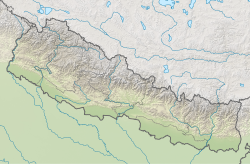| Kulekhani Reservoir | |
|---|---|
 | |
 | |
| Country | Nepal |
| Location | Kulekhani, Indrasarowar Rural Municipality, Makwanpur District, Bagmati Province |
| Coordinates | 27°35′25″N85°9′21″E / 27.59028°N 85.15583°E |
| Purpose | Power |
| Status | Operational |
| Construction began | 1977 |
| Opening date | 1982 |
| Construction cost | US$117.84 million |
| Owner | Nepal Electricity Authority |
| Dam and spillways | |
| Type of dam | Embankment, rock-fill |
| Impounds | Kulekhani River |
| Height | 114 m (374 ft) |
| Length | 397 m (1,302 ft) |
| Elevation at crest | 1,534 m (5,033 ft) |
| Width (crest) | 10 m (33 ft) |
| Dam volume | 4,400,000 m3 (5,800,000 cu yd) |
| Reservoir | |
| Creates | Kulekhani Reservoir (Indra Sarobar) |
| Total capacity | 85,300,000 m3 (69,200 acre⋅ft) |
| Active capacity | 73,300,000 m3 (59,400 acre⋅ft) |
| Inactive capacity | 12,000,000 m3 (9,700 acre⋅ft) |
| Catchment area | 126 km2 (49 sq mi) |
| Surface area | 2.2 km2 (0.85 sq mi) |
| Maximum length | 7 km (4.3 mi) |
| Normal elevation | 1,530 m (5,020 ft) |
| Kulekhani-I Hydropower Station | |
| Coordinates | 27°32′24.81″N85°6′48.82″E / 27.5402250°N 85.1135611°E |
| Commission date | Kulekhani I: 1982 Kulekhani II: 1986 Kulekhani III: 2019 |
| Type | Conventional, diversion |
| Hydraulic head | Kulekhani I: 550 m (1,800 ft) Kulekhani II: 284.1 m (932 ft) Kulekhani III: 102.56 m (336.5 ft) |
| Turbines | Kulekhani I: 2 x 30 MW Pelton-type Kulekhani II: 2 x 16 MW Francis-type Kulekhani III: 2 x 7 MW Francis-type |
| Installed capacity | Kulekhani I: 60 MW Kulekhani II: 32 MW Kulekhani III: 14 MW (est.) Total: 106 MW |
| Annual generation | Kulekhani I: 211 GWh Kulekhani II: 104.6 GWh Kulekhani III: 40.85 GWh (commissioned in 2019) |
The Kulekhani Dam is a rock-fill dam on the Kulekhani River near Kulekhani in the Indrasarowar Rural Municipality of Makwanpur District in Bagmati Province, Nepal. The primary purpose of the dam is hydroelectric power generation and it supports the 60 MW Kulekhani I, 32 MW Kulekhani II and 14 MW Kulekhani III Hydropower Stations. Construction began in 1977 and Kulekhani I was commissioned in 1982. Kulekhani II was commissioned in 1986 and a third power station, the 14 MW Kulekhani III was expected to be commissioned in May 2015 but was delayed due to issues with the builder. The US$117.84 million project received funding from the World Bank, Kuwait Fund, UNDP, Overseas Economic Cooperation Fund and OPEC Fund. It is owned by Nepal Electricity Authority. [1] [2]
Contents
- Kulekhani I hydropower station
- Kulekhani II hydropower station
- Kulekhani III hydropower station
- Gallery
- References
The 114 m (374 ft) tall dam creates a reservoir called Indra Sarobar which stores 85,300,000 m3 (69,200 acre⋅ft) of water.
The Kulekhani Dam in Nepal has a total installed capacity of 106 megawatts (MW):
- Kulekhani I: 60 MW installed capacity
- Kulekhani II: 32 MW installed capacity
- Kulekhani III: 14 MW installed capacity




